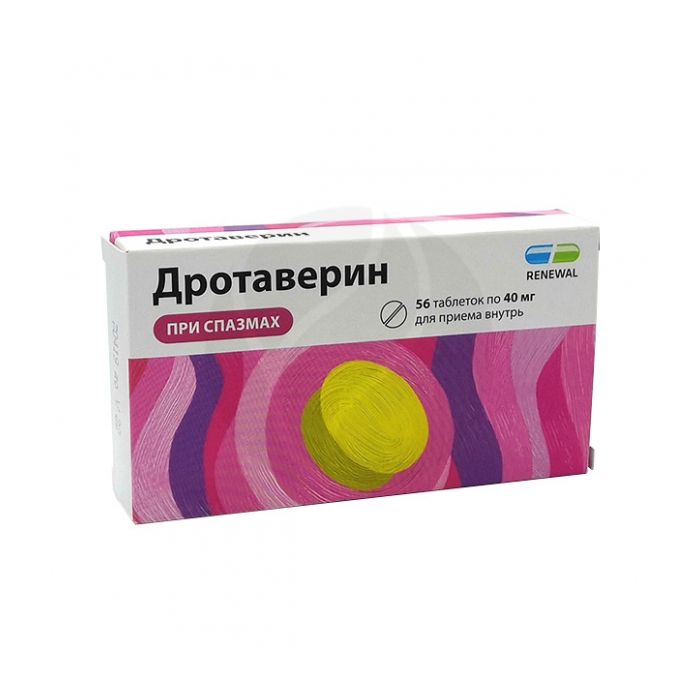Drotaverin tablets 40mg, No. 56
Expiration Date: 11/2025
Russian Pharmacy name:
Дротаверин таблетки 40мг, №56
Prevention and treatment of functional disorders and pain syndrome caused by spasm of smooth muscles (including spasms of the gastrointestinal tract, urinary tract associated with cholelithiasis, cholecystitis, gastric ulcer, duodenal ulcer; spasm of the pyloric and cardiac stomach; spastic constipation, spastic constipation ; proctitis, tenesmus; postoperative colic due to gas retention; due to nephrolithiasis, pyelitis);
when conducting instrumental research;
spasms of peripheral arteries, cerebral vessels;
algodismenorrhea.
to reduce the excitability of the uterus during pregnancy;
with spasm of the pharynx of the uterus in childbirth, prolonged opening of the pharynx, postpartum contractions, threatening abortion.
Inside with a sufficient amount of liquid.
The recommended daily dose for adults is 120-240 mg (2-3 divided doses).
For children aged 6 to 12 years, the maximum daily dose is 80 mg, divided into 2 doses;
For children over 12 years of age, the maximum daily dose is 160 mg, divided into 2-4 doses.
The recommended duration of treatment without consulting a doctor is 1-2 days.
Drotaverine hydrochloride - 40 mg
Severe renal failure
severe liver failure
severe heart failure (low cardiac output syndrome),
lactation period (breastfeeding),
children's age (for parenteral use),
hypersensitivity to drotaverine.
pharmachologic effect
Myotropic antispasmodic. In terms of chemical structure and pharmacological properties, it is close to papaverine, but surpasses it in terms of effectiveness and duration of action. Reduces the tone of smooth muscles of internal organs, reduces their motor activity. Has a vasodilating effect.
Pharmacokinetics
After oral administration, drotaverine is rapidly absorbed from the gastrointestinal tract. Bioavailability is about 100%. Does not penetrate the BBB.
Indications
Prevention and treatment of functional disorders and pain syndrome caused by spasm of smooth muscles (including spasms of the gastrointestinal tract, urinary tract associated with cholelithiasis, cholecystitis, gastric ulcer, duodenal ulcer; spasm of the pyloric and cardiac stomach; spastic constipation, spastic constipation ; proctitis, tenesmus; postoperative colic due to gas retention; due to nephrolithiasis, pyelitis);
when conducting instrumental research;
spasms of peripheral arteries, cerebral vessels; algodismenorrhea.
To reduce the excitability of the uterus during pregnancy; with spasm of the pharynx of the uterus in childbirth, prolonged opening of the pharynx, postpartum contractions, threatening abortion.
Side effect
On the part of the cardiovascular system: palpitations, feeling of heat; with intravenous administration, cases of a decrease in blood pressure (up to collapse), the development of AV blockade, and the appearance of arrhythmias were noted.
On the part of the respiratory system: with intravenous administration, cases of inhibition of the respiratory center have been noted.
Others: dizziness, increased sweating.
Contraindications for use
Severe renal failure
severe liver failure
severe heart failure (low cardiac output syndrome),
lactation period (breastfeeding),
children's age (for parenteral use),
hypersensitivity to drotaverine.
Application during pregnancy and lactation
Use with caution during pregnancy and lactation (breastfeeding).
Application in children
For children under the age of 6 years, when taken orally, a single dose is 10-20 mg, 6-12 years old - 20 mg, the frequency of use is 1-2 times / day.
special instructions
Use with caution in patients with severe atherosclerosis of the coronary arteries, with arterial hypotension.
Drotaverinum can be used as part of combination therapy for the relief of hypertensive crisis.
Use in pediatrics
Use drotaverine (for oral administration) with caution in children. Parenteral use in children is contraindicated.
Drug interactions
With simultaneous use with tricyclic antidepressants, quinidine, procainamide, the decrease in blood pressure caused by tricyclic antidepressants, quinidine and procainamide increases.
With simultaneous use, the spasmogenic activity of morphine decreases.
With simultaneous use with levodopa, it is possible to reduce the antiparkinsonian effect of levodopa.
With simultaneous use, the effect of papaverine, bendazole and other antispasmodics (including m-anticholinergics) is enhanced.
With simultaneous use with phenobarbital, the severity of the antispasmodic effect of drotaverine increases.

